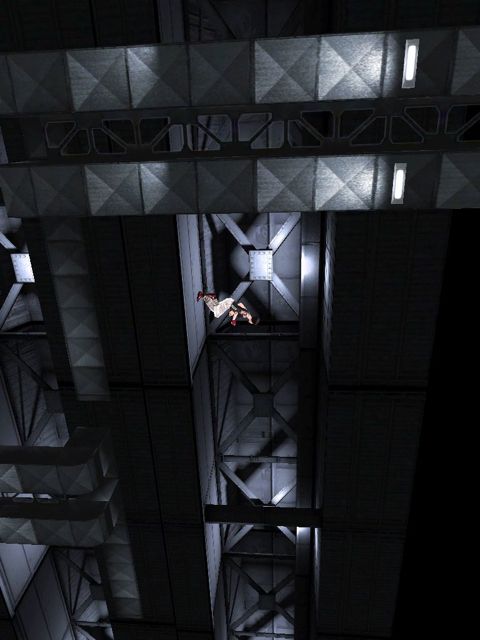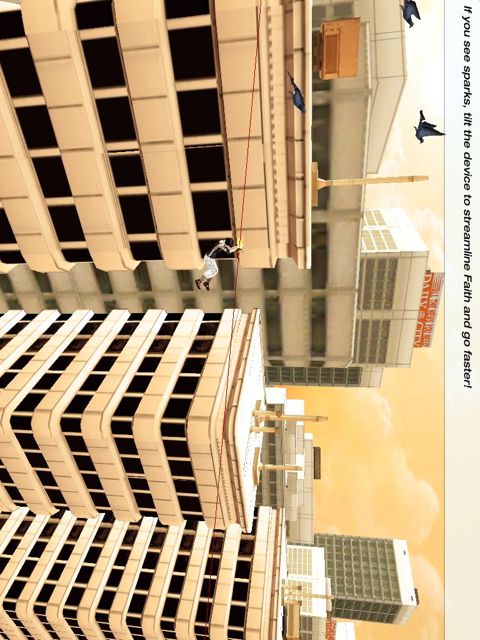Mirror’s Edge for iPad Reviewed
Bringing along its bigger brother’s anthemic theme song “Still Alive” sung by Swedish pop star Lisa Miskovsky and, of course, the parkour mechanic, Mirror’s Edge is a great example of what can be accomplished on the iPad. It’s not, however, without its drawbacks and in many ways exhibits the telltale signs of a mobile game, including formulaic level design and brevity.
But Mirror’s Edge demonstrates a level of polish not common in many 3D iPad titles, albeit one that should be expected from a publisher like EA. The game mechanic of timed jumps, slides and enemy takedowns translates extremely well to the iPad, with a side-scrolling take on 3D that “just works” and circumvents the otherwise often quite obvious 3D limitations of the platform. The controls are where things really get impressive, however. A lot of thought has gone into them, resulting in a fluid and intuitive control mechanism far detached from the tactile-less dual-analogue shoe-horned onto a touch-screen display that’s common in so many other titles. Controlling your protagonist, Faith, is simply a case of swiping in the direction you want to run. Swipe up to jump, swipe down to slide, swipe in the direction you’re running whilst jumping for a flying kick and, if you’re on a zip-line, swipe down to dismount. Oh, and swipe down to roll and absorb the shock of a fall- I’m always forgetting to do that.
Above: one of the unlockable wallpapers. No, sadly the game doesn’t look this good!
Graphically Mirror’s Edge is on the fence, the graphics are neither bad nor impressive, and the fairly repetitive, bland level design doesn’t do them any favours. The splash screen creates an effective combination of stylised, simplistic graphics and the rather catchy theme tune (although its repetition on the last level will make you soon tire of it) which makes for a polished and endearing look right from the outset. It’s a game that, from initial impressions, it’s difficult not to like.
Unfortunately the stylised graphics don’t carry through to the levels themselves, although the music is fairly consistently well chosen. Levels alternate between rooftops at day, rooftops at night or police stations, complex interiors and entrances to pumping stations- the latter all look surprisingly familiar, and the police station is laced with stray crates, foot-thick piping and vents so big that Faith can run through them.
The re-use of effectively the same level design for every interior breaks the otherwise immersive feel of the game, and the paraphernalia found indoors doesn’t lend itself well to any but the last (pumping station entrance) indoor area, and even then only tenuously. Still, the details of your surroundings will blur into an ignorable irrelevant backdrop once you get fully into the run-jump-slide-jump-kick mechanic of the game and they don’t really affect the gameplay, which is the really key element of Mirror’s Edge.
Timed runs and jumps are the mainstay of Mirror’s Edge, and the game doesn’t stay much from this fairly basic but fluid formula. You’ll run into police officers quite often, but taking them down is simply another task of timing a slide or flying kick just right. The same goes for other, hostile free-runners.
The one “boss fight” in the game simply requires a chain of three knock-downs, and the only other enemy to harass you, apart from scenery and jets of steam, is the occasional helicopter coupled with a typical cinematically inaccurate gunner to give you a real sense of urgency and a real need for accuracy when rooftop running.
Roof-top running is made slightly more interesting by the availability of multiple routes, which often aid in your avoidance of Police or lead you to a collectable, in many ways Mirror’s Edge is comparable to Sonic with an emphasis on speed and accuracy, and could probably take a few lessons from the Sonic series to liven it up and add a bit of wholesome frustration!
As dull as it may sound, I played Mirror’s Edge from start to finish, something I can’t say for many games these days. It’s a short, casual yet challenging experience that, to my surprise, I enjoyed. I didn’t get further than playing the demo of the full console Mirror’s Edge experience, but perhaps I will now go and give it a second chance!
One last draw back: plot. There is one, however it’s divulged to you in the time honoured medium of writing, most of which I didn’t bother to read. In-between the latter levels, however, I gave it a chance and got a vague idea of what was going on, but really pined for a few cut-scenes, dialogue.
At around £8, Mirror’s Edge is at the slightly high end of iPad game pricing, particularly as the title is fairly casual. There’s a fair bit of replay value if you’re dead set on grabbing every collectable on each level, and there are also multiplayer features including the ability to duel and race on a single iPad in split-screen mode. Incidentally, the iPad has a bigger screen real estate than other mobile games consoles even when shared. These little touches, coupled with the polish, great music choices, great control scheme and simple accessibility of Mirror’s Edge for iPad probably make it worth the price however, and I would recommend it if you’re even slightly interested. Oh, there are also a few wallpapers, too, if you’re into 3D artistic impressions of cityscapes.
Screenshots – Please tilt head accordingly to view:



